2001 CHRYSLER VOYAGER engine coolant
[x] Cancel search: engine coolantPage 3806 of 4284
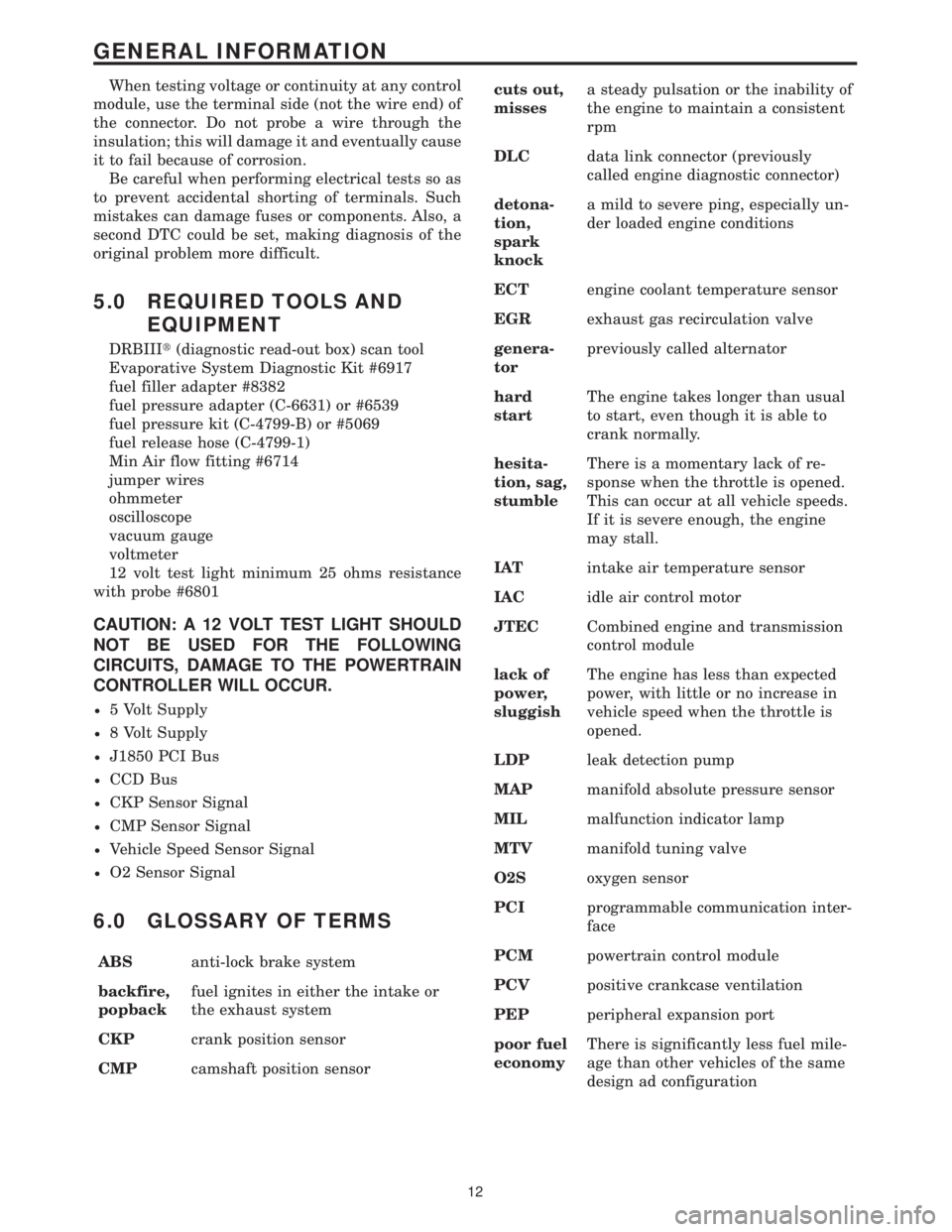
When testing voltage or continuity at any control
module, use the terminal side (not the wire end) of
the connector. Do not probe a wire through the
insulation; this will damage it and eventually cause
it to fail because of corrosion.
Be careful when performing electrical tests so as
to prevent accidental shorting of terminals. Such
mistakes can damage fuses or components. Also, a
second DTC could be set, making diagnosis of the
original problem more difficult.
5.0 REQUIRED TOOLS AND
EQUIPMENT
DRBIIIt(diagnostic read-out box) scan tool
Evaporative System Diagnostic Kit #6917
fuel filler adapter #8382
fuel pressure adapter (C-6631) or #6539
fuel pressure kit (C-4799-B) or #5069
fuel release hose (C-4799-1)
Min Air flow fitting #6714
jumper wires
ohmmeter
oscilloscope
vacuum gauge
voltmeter
12 volt test light minimum 25 ohms resistance
with probe #6801
CAUTION: A 12 VOLT TEST LIGHT SHOULD
NOT BE USED FOR THE FOLLOWING
CIRCUITS, DAMAGE TO THE POWERTRAIN
CONTROLLER WILL OCCUR.
²5 Volt Supply
²8 Volt Supply
²J1850 PCI Bus
²CCD Bus
²CKP Sensor Signal
²CMP Sensor Signal
²Vehicle Speed Sensor Signal
²O2 Sensor Signal
6.0 GLOSSARY OF TERMS
ABSanti-lock brake system
backfire,
popbackfuel ignites in either the intake or
the exhaust system
CKPcrank position sensor
CMPcamshaft position sensorcuts out,
missesa steady pulsation or the inability of
the engine to maintain a consistent
rpm
DLCdata link connector (previously
called engine diagnostic connector)
detona-
tion,
spark
knocka mild to severe ping, especially un-
der loaded engine conditions
ECTengine coolant temperature sensor
EGRexhaust gas recirculation valve
genera-
torpreviously called alternator
hard
startThe engine takes longer than usual
to start, even though it is able to
crank normally.
hesita-
tion, sag,
stumbleThere is a momentary lack of re-
sponse when the throttle is opened.
This can occur at all vehicle speeds.
If it is severe enough, the engine
may stall.
IATintake air temperature sensor
IACidle air control motor
JTECCombined engine and transmission
control module
lack of
power,
sluggishThe engine has less than expected
power, with little or no increase in
vehicle speed when the throttle is
opened.
LDPleak detection pump
MAPmanifold absolute pressure sensor
MILmalfunction indicator lamp
MTVmanifold tuning valve
O2Soxygen sensor
PCIprogrammable communication inter-
face
PCMpowertrain control module
PCVpositive crankcase ventilation
PEPperipheral expansion port
poor fuel
economyThere is significantly less fuel mile-
age than other vehicles of the same
design ad configuration
12
GENERAL INFORMATION
Page 3848 of 4284
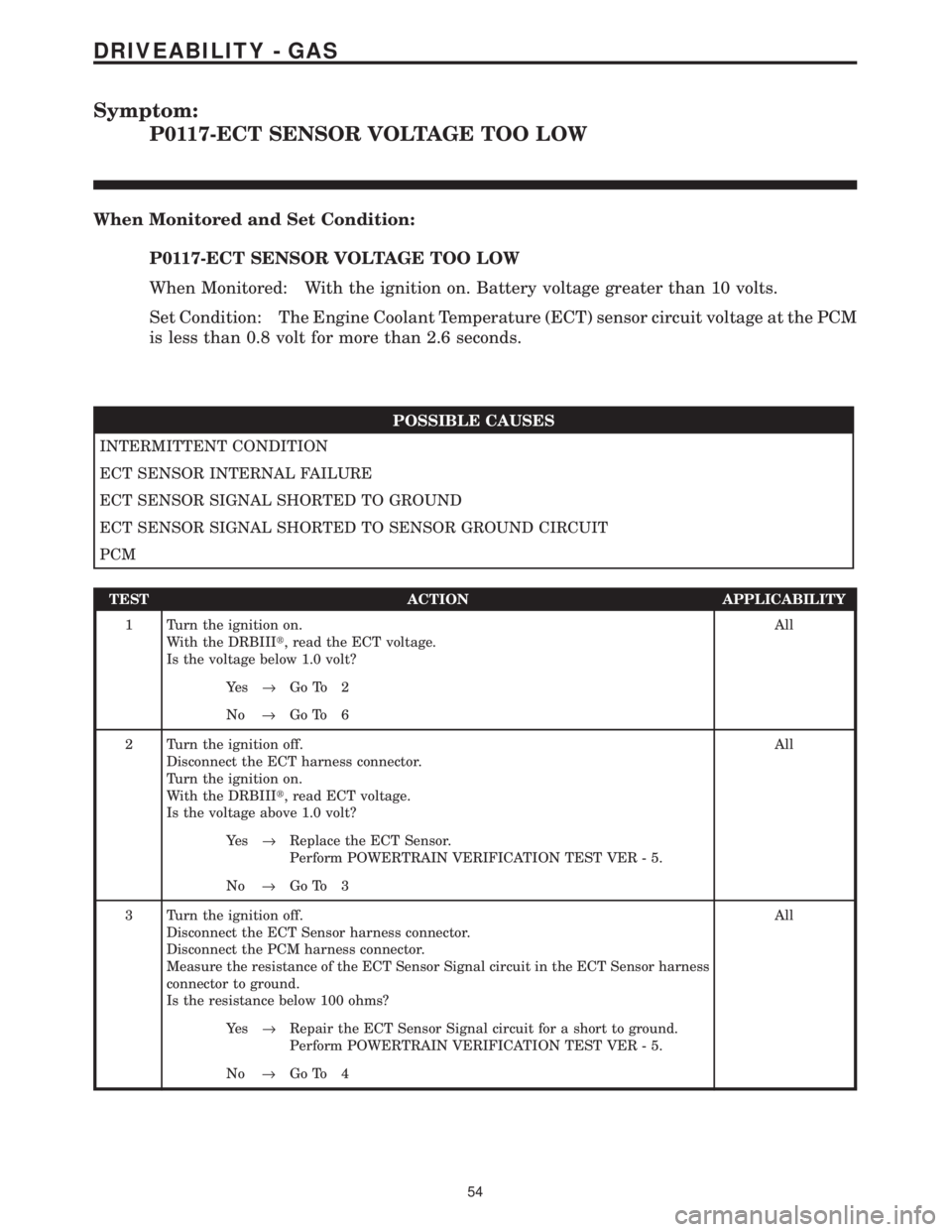
Symptom:
P0117-ECT SENSOR VOLTAGE TOO LOW
When Monitored and Set Condition:
P0117-ECT SENSOR VOLTAGE TOO LOW
When Monitored: With the ignition on. Battery voltage greater than 10 volts.
Set Condition: The Engine Coolant Temperature (ECT) sensor circuit voltage at the PCM
is less than 0.8 volt for more than 2.6 seconds.
POSSIBLE CAUSES
INTERMITTENT CONDITION
ECT SENSOR INTERNAL FAILURE
ECT SENSOR SIGNAL SHORTED TO GROUND
ECT SENSOR SIGNAL SHORTED TO SENSOR GROUND CIRCUIT
PCM
TEST ACTION APPLICABILITY
1 Turn the ignition on.
With the DRBIIIt, read the ECT voltage.
Is the voltage below 1.0 volt?All
Ye s®Go To 2
No®Go To 6
2 Turn the ignition off.
Disconnect the ECT harness connector.
Turn the ignition on.
With the DRBIIIt, read ECT voltage.
Is the voltage above 1.0 volt?All
Ye s®Replace the ECT Sensor.
Perform POWERTRAIN VERIFICATION TEST VER - 5.
No®Go To 3
3 Turn the ignition off.
Disconnect the ECT Sensor harness connector.
Disconnect the PCM harness connector.
Measure the resistance of the ECT Sensor Signal circuit in the ECT Sensor harness
connector to ground.
Is the resistance below 100 ohms?All
Ye s®Repair the ECT Sensor Signal circuit for a short to ground.
Perform POWERTRAIN VERIFICATION TEST VER - 5.
No®Go To 4
54
DRIVEABILITY - GAS
Page 3850 of 4284
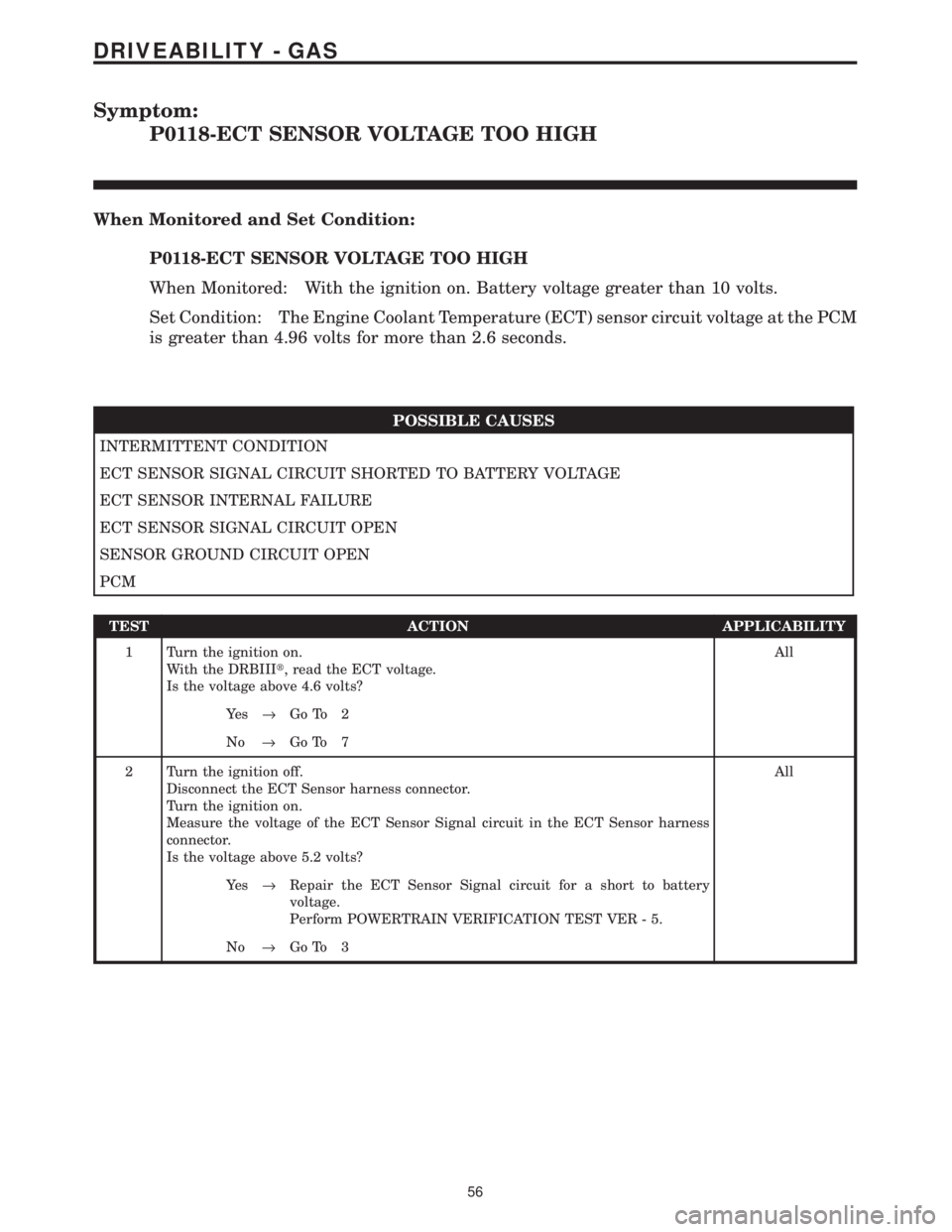
Symptom:
P0118-ECT SENSOR VOLTAGE TOO HIGH
When Monitored and Set Condition:
P0118-ECT SENSOR VOLTAGE TOO HIGH
When Monitored: With the ignition on. Battery voltage greater than 10 volts.
Set Condition: The Engine Coolant Temperature (ECT) sensor circuit voltage at the PCM
is greater than 4.96 volts for more than 2.6 seconds.
POSSIBLE CAUSES
INTERMITTENT CONDITION
ECT SENSOR SIGNAL CIRCUIT SHORTED TO BATTERY VOLTAGE
ECT SENSOR INTERNAL FAILURE
ECT SENSOR SIGNAL CIRCUIT OPEN
SENSOR GROUND CIRCUIT OPEN
PCM
TEST ACTION APPLICABILITY
1 Turn the ignition on.
With the DRBIIIt, read the ECT voltage.
Is the voltage above 4.6 volts?All
Ye s®Go To 2
No®Go To 7
2 Turn the ignition off.
Disconnect the ECT Sensor harness connector.
Turn the ignition on.
Measure the voltage of the ECT Sensor Signal circuit in the ECT Sensor harness
connector.
Is the voltage above 5.2 volts?All
Ye s®Repair the ECT Sensor Signal circuit for a short to battery
voltage.
Perform POWERTRAIN VERIFICATION TEST VER - 5.
No®Go To 3
56
DRIVEABILITY - GAS
Page 3865 of 4284

Symptom:
P0125-CLOSED LOOP TEMP NOT REACHED
When Monitored and Set Condition:
P0125-CLOSED LOOP TEMP NOT REACHED
When Monitored: With battery voltage greater than 10.4 volts, after engine is started.
Set Condition: The engine temperature does not go above 60ÉF (15ÉC). F Time depen-
dants on start-up coolant temperature and ambient temperature. (i.e. 2 minutes for a start
temp of 10ÉC (50ÉF) or up to 10 mintues for a vehicle with a start-up temp of -28ÉC (20ÉF).
Two trips are required to set this DTC.
POSSIBLE CAUSES
LOW COOLANT LEVEL
THERMOSTAT OPERATION
ENGINE COOLANT TEMPERATURE SENSOR
TEST ACTION APPLICABILITY
1NOTE: If a ECT DTC set along with this code, diagnose the ECT DTC first.
NOTE: Inspect the ECT terminals and related PCM terminals. Ensure the
terminals are free from corrosion and damage.
NOTE: The best way to diagnose this DTC is to allow the vehicle to sit
overnight outside in order to have a totally cold soaked engine.
Note: Extremely cold outside ambient temperatures may have caused this
DTC to set.
WARNING: Never open the cooling system when the engine is hot. The
system is under pressure. Extreme burns or scalding may result. Allow the
engine to cool before opening the cooling system.
Check the coolant system to make sure that the coolant is in good condition and at
the proper level.
Is the coolant level and condition OK?All
Ye s®Go To 2
No®Inspect the vehicle for a coolant leak and add the necessary
amount of coolant.
Perform POWERTRAIN VERIFICATION TEST VER - 5.
71
DRIVEABILITY - GAS
Page 3866 of 4284
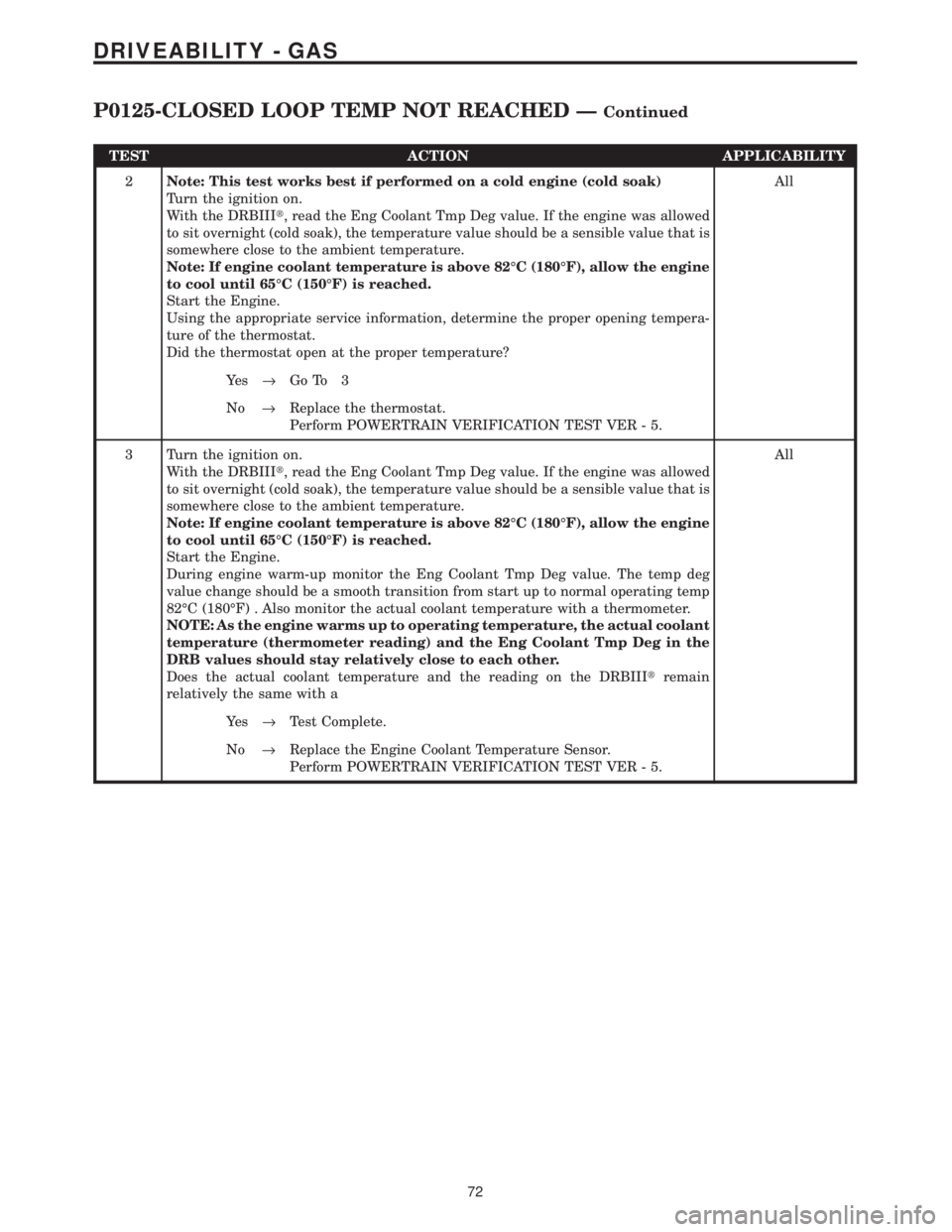
TEST ACTION APPLICABILITY
2Note: This test works best if performed on a cold engine (cold soak)
Turn the ignition on.
With the DRBIIIt, read the Eng Coolant Tmp Deg value. If the engine was allowed
to sit overnight (cold soak), the temperature value should be a sensible value that is
somewhere close to the ambient temperature.
Note: If engine coolant temperature is above 82ÉC (180ÉF), allow the engine
to cool until 65ÉC (150ÉF) is reached.
Start the Engine.
Using the appropriate service information, determine the proper opening tempera-
ture of the thermostat.
Did the thermostat open at the proper temperature?All
Ye s®Go To 3
No®Replace the thermostat.
Perform POWERTRAIN VERIFICATION TEST VER - 5.
3 Turn the ignition on.
With the DRBIIIt, read the Eng Coolant Tmp Deg value. If the engine was allowed
to sit overnight (cold soak), the temperature value should be a sensible value that is
somewhere close to the ambient temperature.
Note: If engine coolant temperature is above 82ÉC (180ÉF), allow the engine
to cool until 65ÉC (150ÉF) is reached.
Start the Engine.
During engine warm-up monitor the Eng Coolant Tmp Deg value. The temp deg
value change should be a smooth transition from start up to normal operating temp
82ÉC (180ÉF) . Also monitor the actual coolant temperature with a thermometer.
NOTE: As the engine warms up to operating temperature, the actual coolant
temperature (thermometer reading) and the Eng Coolant Tmp Deg in the
DRB values should stay relatively close to each other.
Does the actual coolant temperature and the reading on the DRBIIItremain
relatively the same with aAll
Ye s®Test Complete.
No®Replace the Engine Coolant Temperature Sensor.
Perform POWERTRAIN VERIFICATION TEST VER - 5.
72
DRIVEABILITY - GAS
P0125-CLOSED LOOP TEMP NOT REACHED ÐContinued
Page 3867 of 4284
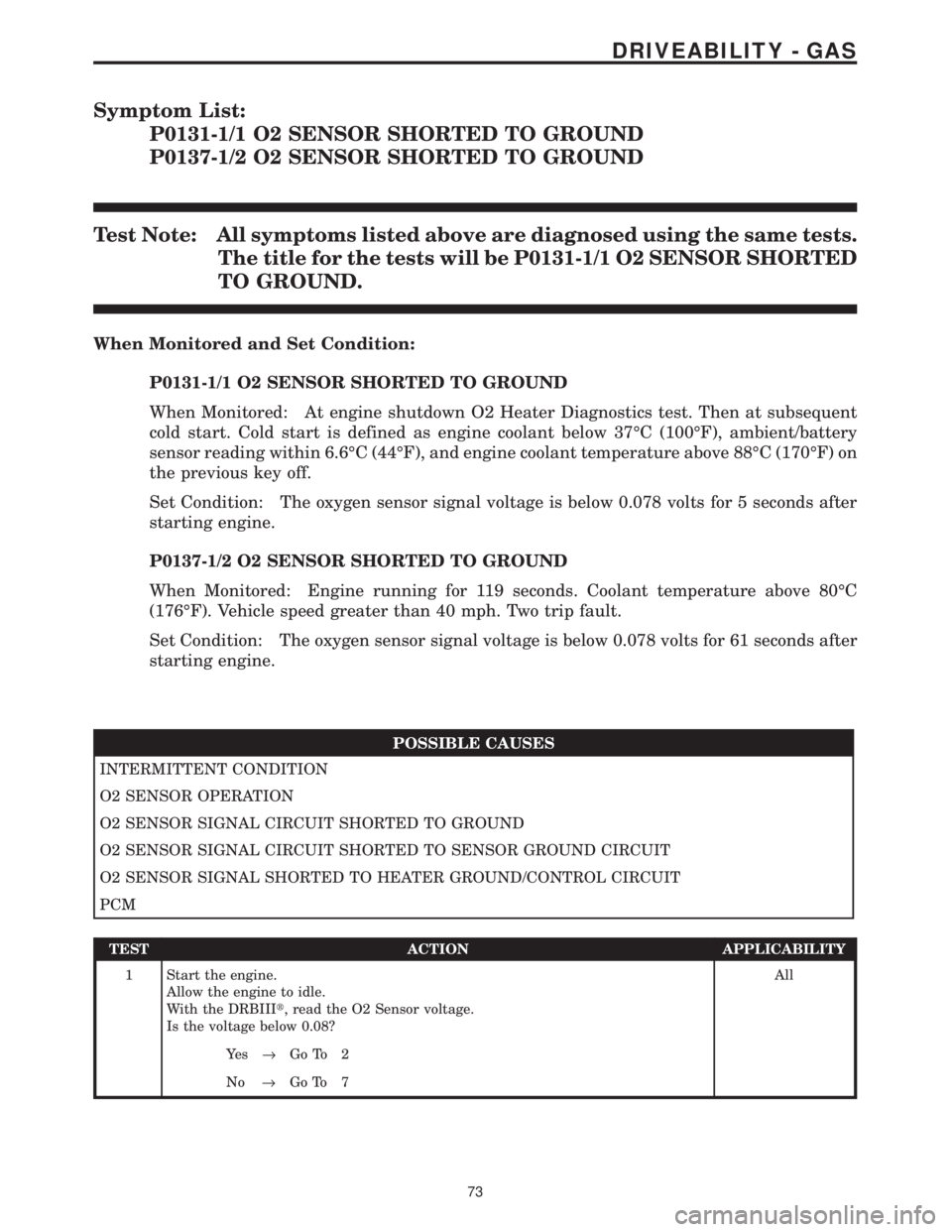
Symptom List:
P0131-1/1 O2 SENSOR SHORTED TO GROUND
P0137-1/2 O2 SENSOR SHORTED TO GROUND
Test Note: All symptoms listed above are diagnosed using the same tests.
The title for the tests will be P0131-1/1 O2 SENSOR SHORTED
TO GROUND.
When Monitored and Set Condition:
P0131-1/1 O2 SENSOR SHORTED TO GROUND
When Monitored: At engine shutdown O2 Heater Diagnostics test. Then at subsequent
cold start. Cold start is defined as engine coolant below 37ÉC (100ÉF), ambient/battery
sensor reading within 6.6ÉC (44ÉF), and engine coolant temperature above 88ÉC (170ÉF) on
the previous key off.
Set Condition: The oxygen sensor signal voltage is below 0.078 volts for 5 seconds after
starting engine.
P0137-1/2 O2 SENSOR SHORTED TO GROUND
When Monitored: Engine running for 119 seconds. Coolant temperature above 80ÉC
(176ÉF). Vehicle speed greater than 40 mph. Two trip fault.
Set Condition: The oxygen sensor signal voltage is below 0.078 volts for 61 seconds after
starting engine.
POSSIBLE CAUSES
INTERMITTENT CONDITION
O2 SENSOR OPERATION
O2 SENSOR SIGNAL CIRCUIT SHORTED TO GROUND
O2 SENSOR SIGNAL CIRCUIT SHORTED TO SENSOR GROUND CIRCUIT
O2 SENSOR SIGNAL SHORTED TO HEATER GROUND/CONTROL CIRCUIT
PCM
TEST ACTION APPLICABILITY
1 Start the engine.
Allow the engine to idle.
With the DRBIIIt, read the O2 Sensor voltage.
Is the voltage below 0.08?All
Ye s®Go To 2
No®Go To 7
73
DRIVEABILITY - GAS
Page 3870 of 4284
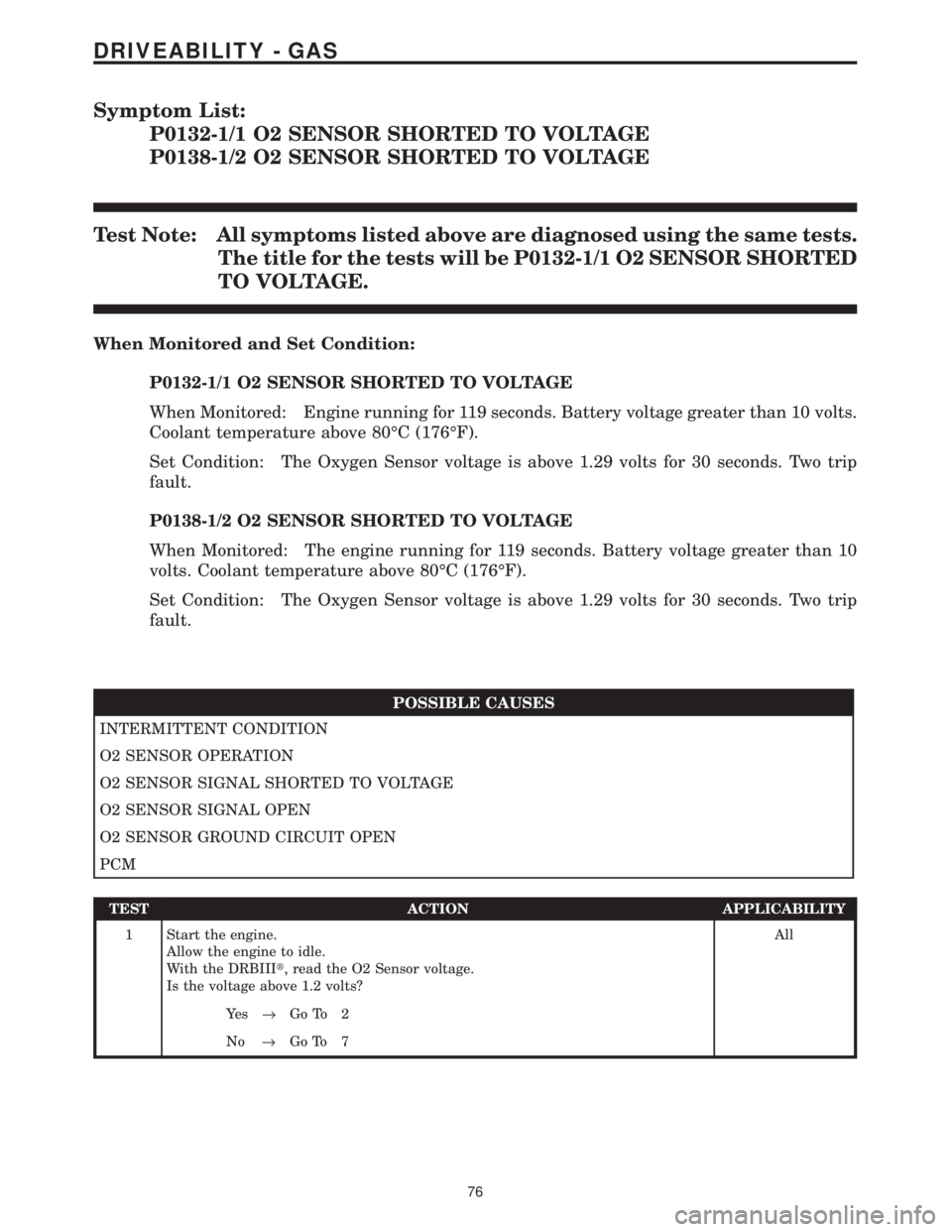
Symptom List:
P0132-1/1 O2 SENSOR SHORTED TO VOLTAGE
P0138-1/2 O2 SENSOR SHORTED TO VOLTAGE
Test Note: All symptoms listed above are diagnosed using the same tests.
The title for the tests will be P0132-1/1 O2 SENSOR SHORTED
TO VOLTAGE.
When Monitored and Set Condition:
P0132-1/1 O2 SENSOR SHORTED TO VOLTAGE
When Monitored: Engine running for 119 seconds. Battery voltage greater than 10 volts.
Coolant temperature above 80ÉC (176ÉF).
Set Condition: The Oxygen Sensor voltage is above 1.29 volts for 30 seconds. Two trip
fault.
P0138-1/2 O2 SENSOR SHORTED TO VOLTAGE
When Monitored: The engine running for 119 seconds. Battery voltage greater than 10
volts. Coolant temperature above 80ÉC (176ÉF).
Set Condition: The Oxygen Sensor voltage is above 1.29 volts for 30 seconds. Two trip
fault.
POSSIBLE CAUSES
INTERMITTENT CONDITION
O2 SENSOR OPERATION
O2 SENSOR SIGNAL SHORTED TO VOLTAGE
O2 SENSOR SIGNAL OPEN
O2 SENSOR GROUND CIRCUIT OPEN
PCM
TEST ACTION APPLICABILITY
1 Start the engine.
Allow the engine to idle.
With the DRBIIIt, read the O2 Sensor voltage.
Is the voltage above 1.2 volts?All
Ye s®Go To 2
No®Go To 7
76
DRIVEABILITY - GAS
Page 3873 of 4284
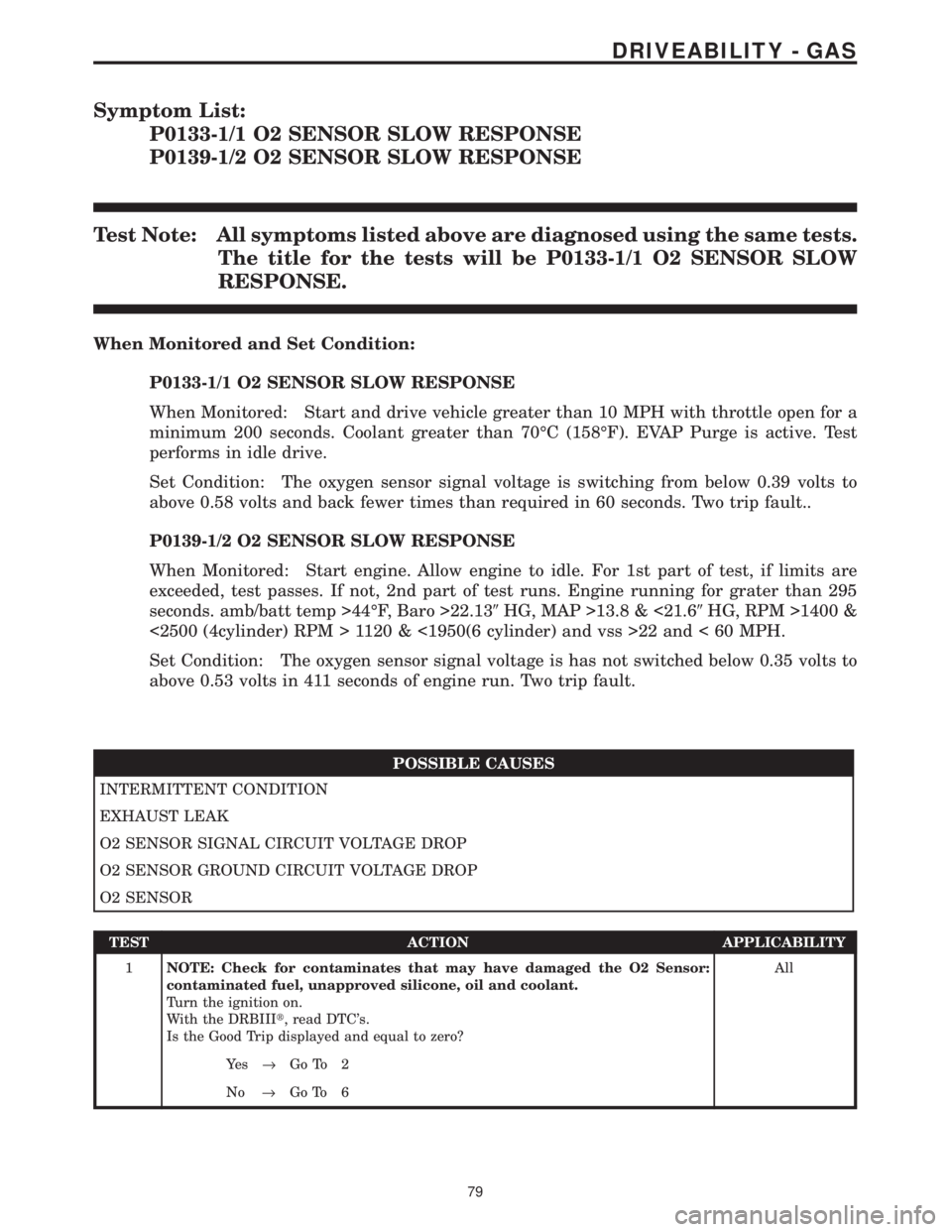
Symptom List:
P0133-1/1 O2 SENSOR SLOW RESPONSE
P0139-1/2 O2 SENSOR SLOW RESPONSE
Test Note: All symptoms listed above are diagnosed using the same tests.
The title for the tests will be P0133-1/1 O2 SENSOR SLOW
RESPONSE.
When Monitored and Set Condition:
P0133-1/1 O2 SENSOR SLOW RESPONSE
When Monitored: Start and drive vehicle greater than 10 MPH with throttle open for a
minimum 200 seconds. Coolant greater than 70ÉC (158ÉF). EVAP Purge is active. Test
performs in idle drive.
Set Condition: The oxygen sensor signal voltage is switching from below 0.39 volts to
above 0.58 volts and back fewer times than required in 60 seconds. Two trip fault..
P0139-1/2 O2 SENSOR SLOW RESPONSE
When Monitored: Start engine. Allow engine to idle. For 1st part of test, if limits are
exceeded, test passes. If not, 2nd part of test runs. Engine running for grater than 295
seconds. amb/batt temp >44ÉF, Baro >22.139HG, MAP >13.8 & <21.69HG, RPM >1400 &
<2500 (4cylinder) RPM > 1120 & <1950(6 cylinder) and vss >22 and < 60 MPH.
Set Condition: The oxygen sensor signal voltage is has not switched below 0.35 volts to
above 0.53 volts in 411 seconds of engine run. Two trip fault.
POSSIBLE CAUSES
INTERMITTENT CONDITION
EXHAUST LEAK
O2 SENSOR SIGNAL CIRCUIT VOLTAGE DROP
O2 SENSOR GROUND CIRCUIT VOLTAGE DROP
O2 SENSOR
TEST ACTION APPLICABILITY
1NOTE: Check for contaminates that may have damaged the O2 Sensor:
contaminated fuel, unapproved silicone, oil and coolant.
Turn the ignition on.
With the DRBIIIt, read DTC's.
Is the Good Trip displayed and equal to zero?All
Ye s®Go To 2
No®Go To 6
79
DRIVEABILITY - GAS